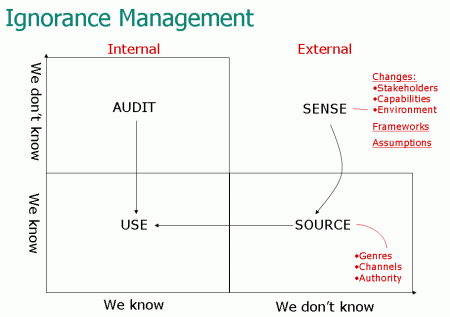Introducing the Rumsfeld Ignorance Management Framework
A couple of weeks ago I wrote about Donald Rumsfeld’s contribution to ignorance management. This past week I’ve been working with a client in Rome on ways of improving their sensitivity to their external environment, and I’ve been using what I call the Rumsfeld Ignorance Management Framework. It’s turned out to be pretty useful, so I thought I’d share it here.

Known Knowns
The bottom left quadrant is the simplest, it describes the things that we know we know. Here, the real sixty-five thousand dollar question is whether the information and knowledge we have is actually used in making decisions about the business. A LOT of decisions, we agreed, were made on hasty assumptions without going back to check.
Unknown Knowns
Moving north, we have the things we don’t know we know. Rumsfeld never actually covered this ignorance domain, but what the heck, we’ll still give him credit. This is the area where knowledge and information management kicks in: people who are making decisions are not aware of relevant and important information and knowledge that the organisation already possesses. So this is where structured knowledge and information audits can help to raise the visibility of knowledge and information assets to those who can usefully deploy them.
Known Unknowns
In the bottom right domain we have the things we know we don’t know, but need to: the gaps, the worrying but significant questions that we feel need answers. This is the domain of business and competitive intelligence. We need to frame precise questions, and then figure out the kind of information and knowledge carriers or sources that are likely to hold answers to these questions (experts, research reports, publications, website?), where these sources are likely to be found, the channels where this information flows. We also need to have a good sense of how to judge the relative authority and value of the sources. Once found, of course, they migrate into the known knowns domain, as candidates for use.
Unknown Unknowns
This is the domain that creased up the American media when Rumsfeld pronounced. These are the most difficult things to pin down, the things we don’t know we don’t know. Sometimes the importance of this domain shows up in a general sense of unease, that things seem too simple, that there’s something going on that we are not equipped to see. I’ve shown this here as an open domain, and this is where we go prospecting, blundering around in the fog carefully bumping into things and giving them shape as questions. Once they are fairly well-formed as questions, we have known unknowns, and can start a structured search for answers. In this domain, curiosity, sensitivity to details, noticing and exploring differences of perception among different people, and alertness to small changes, are all invaluable practices. Itemising our basic assumptions and challenging them produces very good candidates for known-unknown questions. If we want to pick up weak signals of important changes that require an early response, then we need to be particularly sensitive to what we know or assume about our stakeholders and how that changes over time, also our capabilities mapped against those of our competitors, and other changes in our external environment. This is the domain where structured frameworks such as Porter’s Five Forces come into their own, because the use of these structures almost always shows up gaps in our thinking and knowledge.
As the diagram suggests, the Rumsfeld Ignorance Management Framework is all about dynamics: prospecting in the unknown unknown domain to generate useful questions, which can be sourced in the known unknown domain, and brought across to the known knowns for application and use. Similarly, with internally held knowledge, auditing and publicising the presence of relevant knowledge, so that it too can become incorporated into known knowns and usefully applied. It’s all about enlarging the known knowns domain through disciplined practices and activities in the domains of ignorance.
3 Comments so far
- Patrick
Hi Luke
Thanks for this. You’re right, I have treated this very much from the organizational perspective. Do you have any links for Inyatullah?
This article by Sohail has his 6 box knowledge and ignorance approach on it. It’a about teaching futures studies - and one of the better articles around that scopes the field of futures studies.
http://www.metafuture.org/Articles/teachingfuturestudies.htm
Page 1 of 1 pages
Comment Guidelines: Basic XHTML is allowed (<strong>, <em>, <a>) Line breaks and paragraphs are automatically generated. URLs are automatically converted into links.

Patrick
I like it but I think that you are missing some important elements. Inayatullah (before Rumsfeld) has a six square model which probably is not so good for consultants who prefer more simple 2x2 models.
We can divide the known knowns from the knowns. There are things that we know which are untested and there are things which are known knowns that are tested (through scientific hypothesis testing a la Popper). You mentioned hasty decisions are made on the knowns - more considered decisions are made on the known knowns. A useful split I think.
Unknown knowns. You state this from an organisational perspective which is valuable. There is another perspective from the individual as well. That is the intuitive side - gut decisions - Gladwell’s Blink. Here, you don’t know it cognitively but you feel it energetically or intuitively. This could be based on prejudice or on well-honed intuitive capabilities.
The unknown unknowns also have an epistemological aspect. To me, this is beyond sensing but actively engaging in different ways of knowing - not just exploring our own assumptions but seeing the situation through eyes with different assumptions. It requires openness, not just sensing. Models are useful here but can only ever be partial. I like how the unknown unknowns are unbounded in your diagram.
Posted on August 11, 2006 at 03:32 PM | Comment permalink